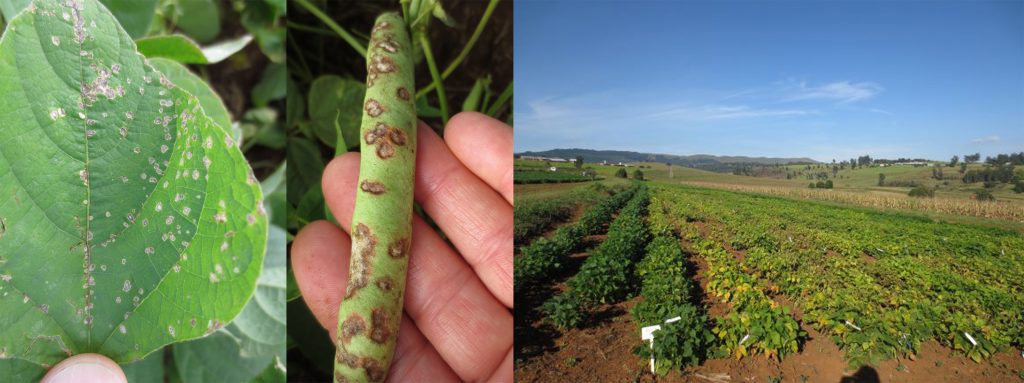Two generations of PIC population selections and advanced lines under consideration for release were evaluated at the ARC Station in Cedara for disease resistance, under high temperature at the ARC Station in Vaalharts, and at Potchefstroom from 3/27-4/2/19.
In the trials at Cedara, the principal disease was scab with both pod and leaf symptoms identified (photo below), but halo blight, rust, and angular leaf spot (ALS) were also found. An advanced first-generation of PIC population selections, with 80 entries in 3 replications from populations 1 to 153, were evaluated for potential release. A second set of PIC selections, from a second generation of PIC populations 154 to 275 and composed of 677 lines, were also evaluated in 3 replications. All plots were evaluated for pod load (1-9 scale), maturity (1-3 scale), and disease response (1-9 scale) and preliminary selections were completed.
At the Jan Kempdorp ARC Station in Vaalharts response to high temperature stress was evaluated. The bean trial at the Vaalharts field site was located at 27⁰56.759 S, 24⁰50.548 E and at 1162 masl and has average temperatures of 35-38⁰C (day) and 16-18⁰C night during the season. Visual ratings based on pod load were completed on the same set of 80 PIC lines as indicated above in three replications and on 285 lines (previously selected in Vaalharts) from the second generation mentioned above. In addition to pod load, disease response, maturity, and virus-like symptom data was also collected.

Vaalharts photos from left to right: Drs. Miklas, Fourie, and Porch at Vaalharts trials, virus symptoms, heat-adapted versus sensitive lines.
At the Potchefstroom trials of Deidre Fourie selections from the PIC breeding lines with a sugar or calima seed type were evaluated for potential release in South Africa. A number of these lines had promising yield potential in Potchefstroom. RILs from the Rojo x CAL 143 population combining multiple disease resistance were also evaluated for yield potential, seed type, and for potential release.
A subset of these PIC lines with commercial seed type will be evaluated in yield trials in South Africa, and sent to U.S. collaborators for phenotypic and genotypic evaluation and for potential release or use in breeding programs in the U.S.

